PEUGEOT 308 CC 2013 Manual PDF
Manufacturer: PEUGEOT, Model Year: 2013, Model line: 308 CC, Model: PEUGEOT 308 CC 2013Pages: 268, PDF Size: 15.28 MB
Page 71 of 268
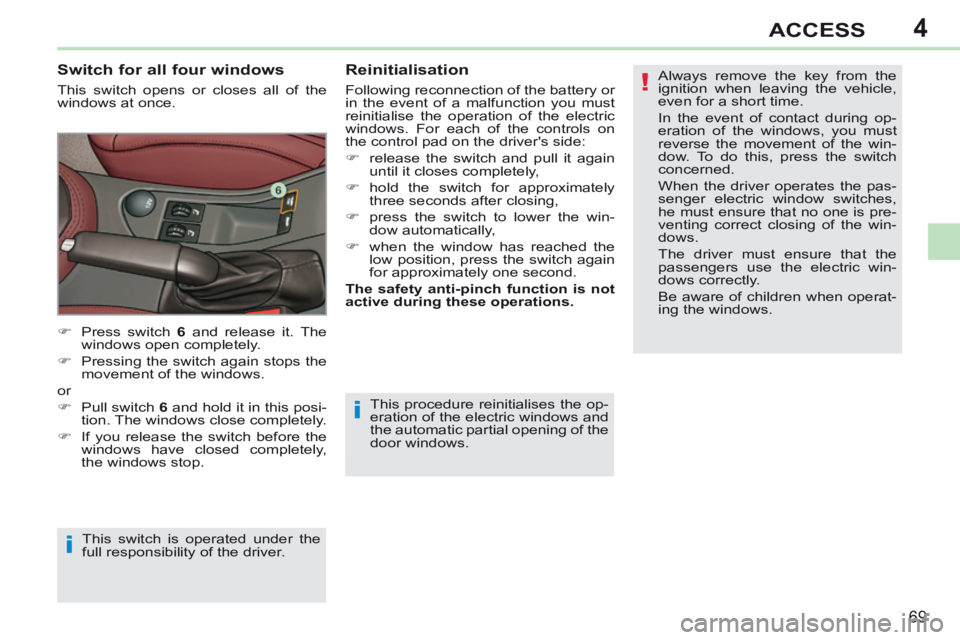
4
!
i
i
69
ACCESS
This procedure reinitialises the op-
eration of the electric windows and
the automatic partial opening of the
door windows .
Switch for all four windows
This switch opens or closes all of the
windows at once. Always remove the key from the
ignition when leaving the vehicle,
even for a short time.
In the event of contact during op-
eration of the windows, you must
reverse the movement of the win-
dow. To do this, press the switch
concerned.
When the driver operates the pas-
senger electric window switches,
he must ensure that no one is pre-
venting correct closing of the win-
dows.
The driver must ensure that the
passengers use the electric win-
dows correctly.
Be aware of children when operat-
ing the windows.
Reinitialisation
Following reconnection of the battery or
in the event of a malfunction you must
reinitialise the operation of the electric
windows. For each of the controls on
the control pad on the driver's side:
release the switch and pull it again
until it closes completely,
hold the switch for approximately three seconds after closing,
press the switch to lower the win- dow automatically,
when the window has reached the low position, press the switch again
for approximately one second.
The safety anti-pinch function is not
active during these operations.
Press switch 6 and release it. The
windows open completely.
Pressing the switch again stops the movement of the windows.
or
Pull switch 6 and hold it in this posi-
tion. The windows close completely.
If you release the switch before the windows have closed completely,
the windows stop.
This switch is operated under the
full responsibility of the driver.
Page 72 of 268
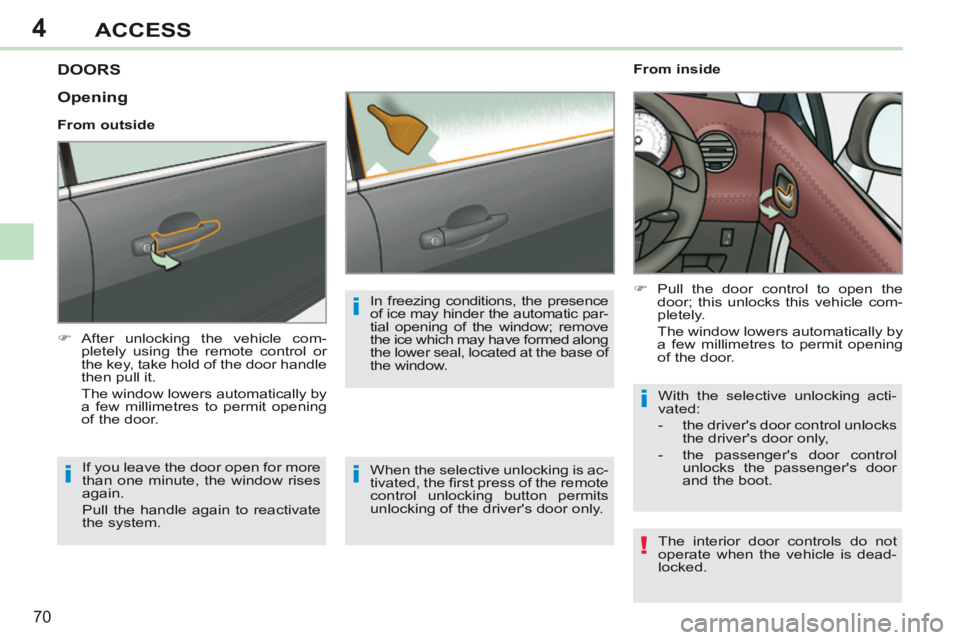
4
!
i
i
i
i
70
ACCESS
DOORS
After unlocking the vehicle com-pletely using the remote control or
the key, take hold of the door handle
then pull it.
The window lowers automatically by a few millimetres to permit opening
of the door. From inside
Pull the door control to open the
door; this unlocks this vehicle com-
pletely.
The window lowers automatically by a few millimetres to permit opening
of the door.
The interior door controls do not
operate when the vehicle is dead-
locked.
If you leave the door open for more
than one minute, the window rises
again.
Pull the handle again to reactivate
the system.
Opening
From outside
When the selective unlocking is ac-
tivated, the fi rst press of the remote
control unlocking button permits
unlocking of the driver's door only. With the selective unlocking acti-
vated:
- the driver's door control unlocks
the driver's door only,
- the passenger's door control unlocks the passenger's door
and the boot.
In freezing conditions, the presence
of ice may hinder the automatic par-
tial opening of the window; remove
the ice which may have formed along
the lower seal, located at the base of
the window.
Page 73 of 268
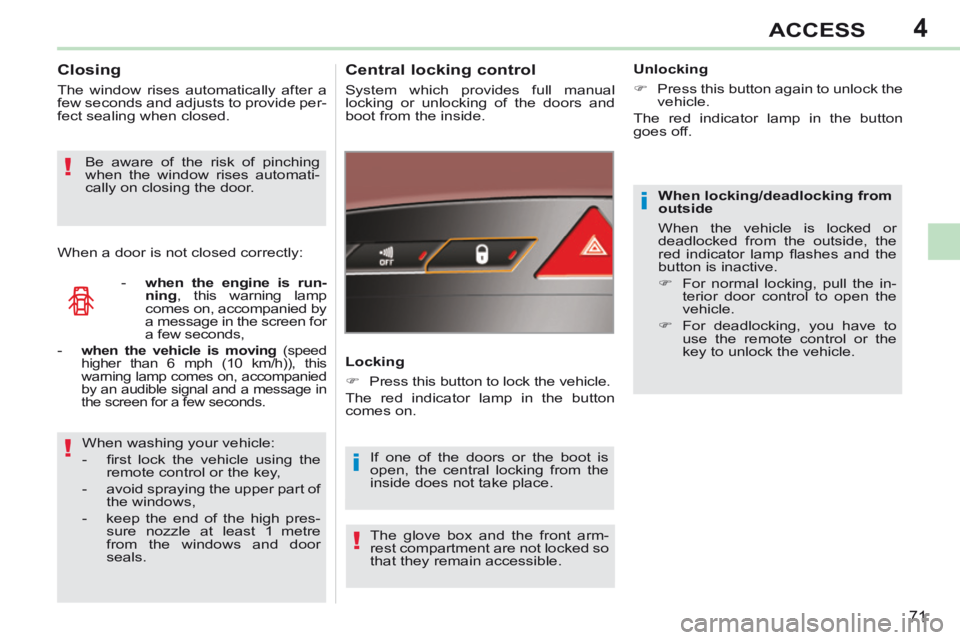
4
i
i!
!
!
71
ACCESS
When locking/deadlocking from
outside
When the vehicle is locked or
deadlocked from the outside, the
red indicator lamp fl ashes and the
button is inactive.
For normal locking, pull the in-terior door control to open the
vehicle.
For deadlocking, you have to use the remote control or the
key to unlock the vehicle.
Central locking control
System which provides full manual
locking or unlocking of the doors and
boot from the inside.
Locking
Press this button to lock the vehicle.
The red indicator lamp in the button
comes on.
If one of the doors or the boot is
open, the central locking from the
inside does not take place. Unlocking
Press this button again to unlock the
vehicle.
The red indicator lamp in the button
goes off.
Closing
The window rises automatically after a
few seconds and adjusts to provide per-
fect sealing when closed.
- when the engine is run-ning , this warning lamp
comes on, accompanied by
a message in the screen for
a few seconds,
When washing your vehicle:
- fi rst lock the vehicle using the remote control or the key,
- avoid spraying the upper part of the windows,
- keep the end of the high pres- sure nozzle at least 1 metre
from the windows and door
seals.
When a door is not closed correctly:
Be aware of the risk of pinching
when the window rises automati-
cally on closing the door.
The glove box and the front arm-
rest compartment are not locked so
that they remain accessible.
-
when the vehicle is moving (speed
higher than 6 mph (10 km/h)), this
warning lamp comes on, accompanied
by an audible signal and a message in
the screen for a few seconds.
Page 74 of 268
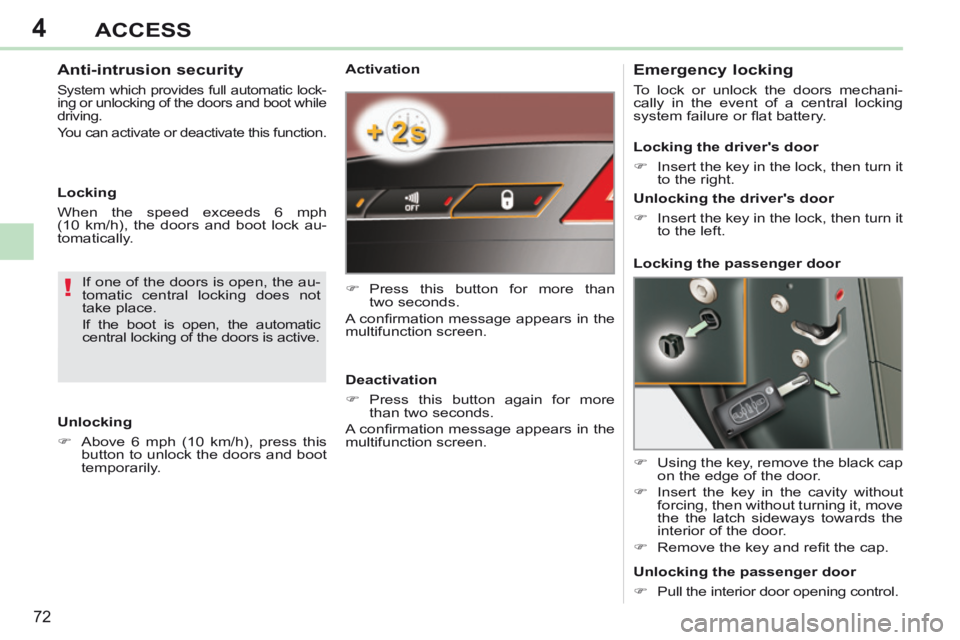
4
!
72
ACCESS
Activation
Press this button for more than two seconds.
A confi rmation message appears in the
multifunction screen.
Deactivation
Press this button again for more than two seconds.
A confi rmation message appears in the
multifunction screen. Emergency locking
To lock or unlock the doors mechani-
cally in the event of a central locking
system failure or fl at battery.
Using the key, remove the black cap on the edge of the door.
Insert the key in the cavity without forcing, then without turning it, move
the the latch sideways towards the
interior of the door.
Remove the key and refi t the cap. Locking the driver's door
Insert the key in the lock, then turn it to the right.
Unlocking the driver's door
Insert the key in the lock, then turn it to the left.
Locking the passenger door
Unlocking the passenger door
Pull the interior door opening control.
If one of the doors is open, the au-
tomatic central locking does not
take place.
If the boot is open, the automatic
central locking of the doors is active.
Anti-intrusion security
System which provides full automatic lock-
ing or unlocking of the doors and boot while
driving.
You can activate or deactivate this function.
Unlocking
Above 6 mph (10 km/h), press this
button to unlock the doors and boot
temporarily.
Locking
When the speed exceeds 6 mph
(10 km/h), the doors and boot lock au-
tomatically.
Page 75 of 268
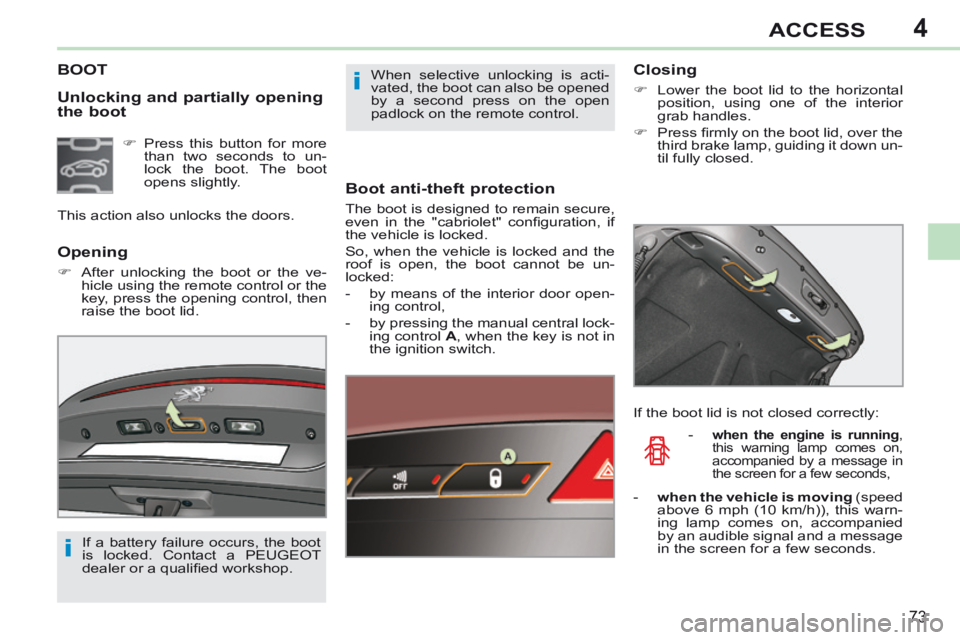
4
i
i
73
ACCESS
Unlocking and partially opening
the boot
BOOT
Boot anti-theft protection
The boot is designed to remain secure,
even in the "cabriolet" confi guration, if
the vehicle is locked.
So, when the vehicle is locked and the
roof is open, the boot cannot be un-
locked:
- by means of the interior door open-ing control,
- by pressing the manual central lock- ing control A , when the key is not in
the ignition switch.
Opening
After unlocking the boot or the ve- hicle using the remote control or the
key, press the opening control, then
raise the boot lid. When selective unlocking is acti-
vated, the boot can also be opened
by a second press on the open
padlock on the remote control.
Press this button for more than two seconds to un-
lock the boot. The boot
opens slightly.
This action also unlocks the doors.
If a battery failure occurs, the boot
is locked. Contact a PEUGEOT
dealer or a qualifi ed workshop.
Closing
Lower the boot lid to the horizontal position, using one of the interior
grab handles.
Press fi rmly on the boot lid, over the third brake lamp, guiding it down un-
til fully closed.
If the boot lid is not closed correctly: -
when the engine is running ,
this warning lamp comes on,
accompanied by a message in
the screen for a few seconds,
- when the vehicle is moving (speed above 6 mph (10 km/h)), this warn-
ing lamp comes on, accompanied
by an audible signal and a message
in the screen for a few seconds.
Page 76 of 268
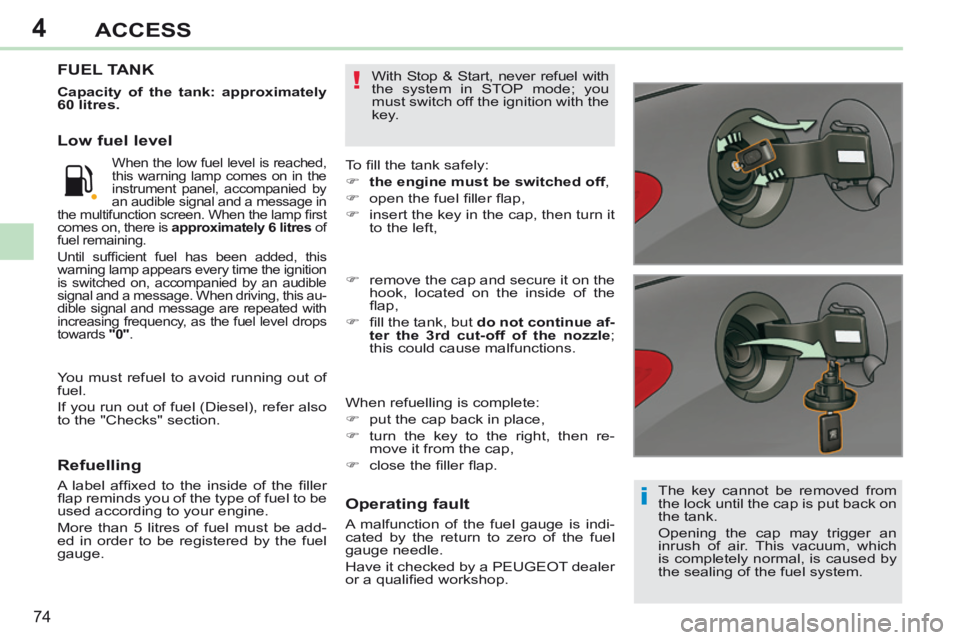
4
i
!
74
ACCESS
The key cannot be removed from
the lock until the cap is put back on
the tank.
Opening the cap may trigger an
inrush of air. This vacuum, which
is completely normal, is caused by
the sealing of the fuel system.
FUEL TANK
To fi ll the tank safely:
the engine must be switched off,
open the fuel fi ller fl ap,
insert the key in the cap, then turn it to the left,
When refuelling is complete:
put the cap back in place,
turn the key to the right, then re- move it from the cap,
close the fi ller fl ap. remove the cap and secure it on the hook, located on the inside of the
fl ap,
fi ll the tank, but do not continue af-
ter the 3rd cut-off of the nozzle ;
this could cause malfunctions.
Capacity of the tank: approximately
60 litres.
Refuelling
A label affi xed to the inside of the fi ller
fl ap reminds you of the type of fuel to be
used according to your engine.
More than 5 litres of fuel must be add-
ed in order to be registered by the fuel
gauge.
When the low fuel level is reached,
this warning lamp comes on in the
instrument panel, accompanied by
an audible signal and a message in
the multifunction screen. When the lamp fi rst
comes on, there is approximately 6 litres of
fuel remaining.
Until suffi cient fuel has been added, this
warning lamp appears every time the ignition
is switched on, accompanied by an audible
signal and a message. When driving, this au-
dible signal and message are repeated with
increasing frequency, as the fuel level drops
towards "0" .
Operating fault
A malfunction of the fuel gauge is indi-
cated by the return to zero of the fuel
gauge needle.
Have it checked by a PEUGEOT dealer
or a qualifi ed workshop. With Stop & Start, never refuel with
the system in STOP mode; you
must switch off the ignition with the
key.
Low fuel level
You must refuel to avoid running out of
fuel.
If you run out of fuel (Diesel), refer also
to the "Checks" section.
Page 77 of 268
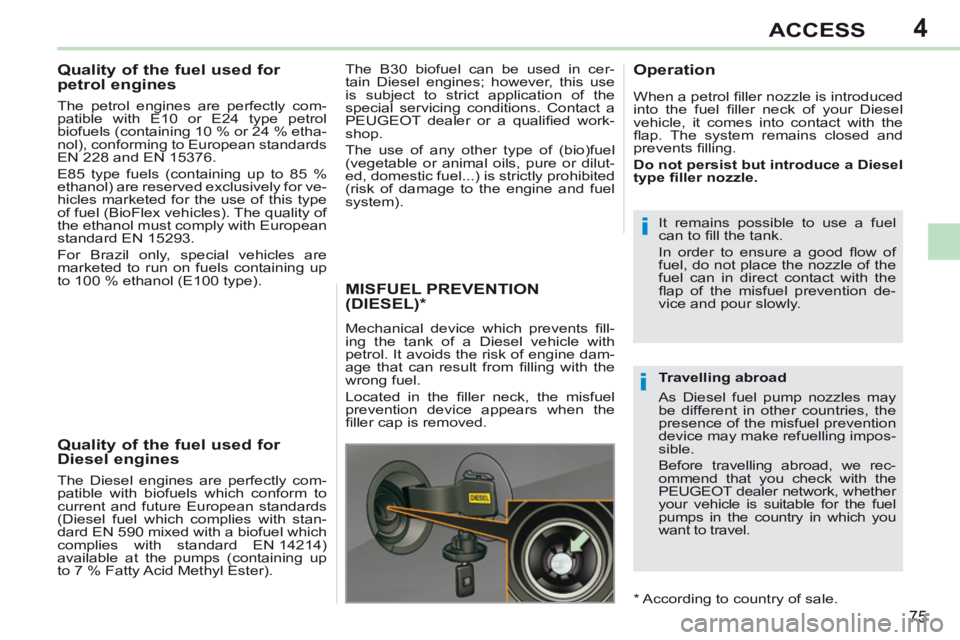
4
i
i
75
ACCESS
Quality of the fuel used for
petrol engines
The petrol engines are perfectly com-
patible with E10 or E24 type petrol
biofuels (containing 10 % or 24 % etha-
nol), conforming to European standards
EN 228 and EN 15376.
E85 type fuels (containing up to 85 %
ethanol) are reserved exclusively for ve-
hicles marketed for the use of this type
of fuel (BioFlex vehicles). The quality of
the ethanol must comply with European
standard EN 15293.
For Brazil only, special vehicles are
marketed to run on fuels containing up
to 100 % ethanol (E100 type).
Quality of the fuel used for
Diesel engines
The Diesel engines are perfectly com-
patible with biofuels which conform to
current and future European standards
(Diesel fuel which complies with stan-
dard EN 590 mixed with a biofuel which
complies with standard EN 14214)
available at the pumps (containing up
to 7 % Fatty Acid Methyl Ester).
MISFUEL PREVENTION (DIESEL) *
Mechanical device which prevents fi ll-
ing the tank of a Diesel vehicle with
petrol. It avoids the risk of engine dam-
age that can result from fi lling with the
wrong fuel.
Located in the fi ller neck, the misfuel
prevention device appears when the
fi ller cap is removed.
Operation
It remains possible to use a fuel
can to fi ll the tank.
In order to ensure a good fl ow of
fuel, do not place the nozzle of the
fuel can in direct contact with the
fl ap of the misfuel prevention de-
vice and pour slowly.
When a petrol fi ller nozzle is introduced
into the fuel fi ller neck of your Diesel
vehicle, it comes into contact with the
fl ap. The system remains closed and
prevents fi lling.
Do not persist but introduce a Diesel
type fi ller nozzle.
Travelling abroad
As Diesel fuel pump nozzles may
be different in other countries, the
presence of the misfuel prevention
device may make refuelling impos-
sible.
Before travelling abroad, we rec-
ommend that you check with the
PEUGEOT dealer network, whether
your vehicle is suitable for the fuel
pumps in the country in which you
want to travel.
The B30 biofuel can be used in cer-
tain Diesel engines; however, this use
is subject to strict application of the
special servicing conditions. Contact a
PEUGEOT dealer or a qualifi ed work-
shop.
The use of any other type of (bio)fuel
(vegetable or animal oils, pure or dilut-
ed, domestic fuel...) is strictly prohibited
(risk of damage to the engine and fuel
system).
* According to country of sale.
Page 78 of 268
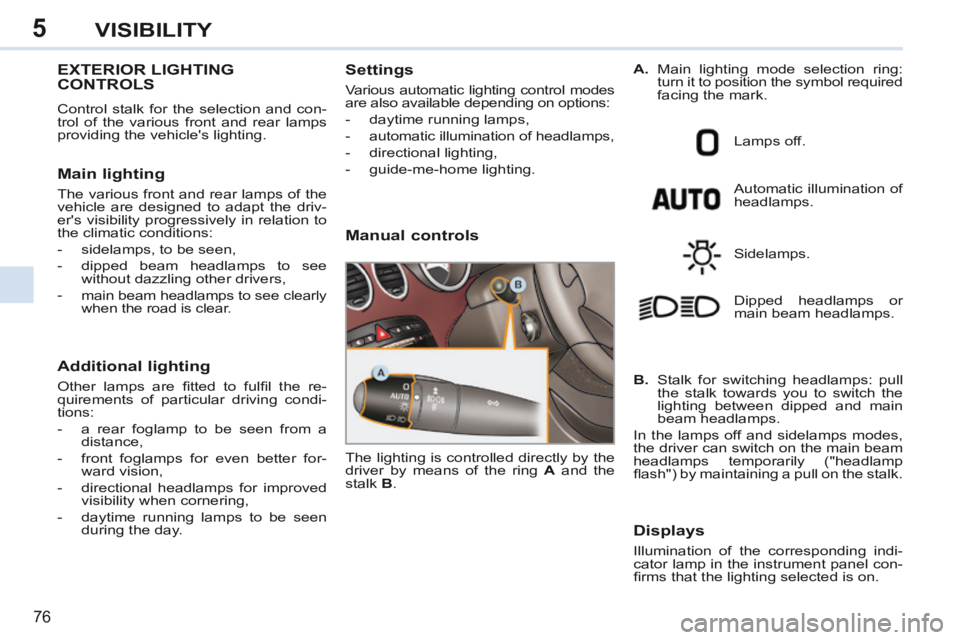
5
76
VISIBILITY
EXTERIOR LIGHTING CONTROLS
Control stalk for the selection and con-
trol of the various front and rear lamps
providing the vehicle's lighting.
Main lighting
The various front and rear lamps of the
vehicle are designed to adapt the driv-
er's visibility progressively in relation to
the climatic conditions:
- sidelamps, to be seen,
- dipped beam headlamps to see without dazzling other drivers,
-
main beam headlamps to see clearly
when the road is clear.
Additional lighting
Other lamps are fi tted to fulfi l the re-
quirements of particular driving condi-
tions:
- a rear foglamp to be seen from a distance,
- front foglamps for even better for- ward vision,
- directional headlamps for improved visibility when cornering,
- daytime running lamps to be seen during the day.
Settings
Various automatic lighting control modes
are also available depending on options:
- daytime running lamps,
- automatic illumination of headlamps,
- directional lighting,
- guide-me-home lighting.
Manual controls
Automatic illumination of
headlamps.
The lighting is controlled directly by the
driver by means of the ring A and the
stalk B . Lamps off.
Sidelamps.
B. Stalk for switching headlamps: pull the stalk towards you to switch the
lighting between dipped and main
beam headlamps.
In the lamps off and sidelamps modes,
the driver can switch on the main beam
headlamps temporarily ("headlamp
fl ash") by maintaining a pull on the stalk. Dipped headlamps or
main beam headlamps.
Displays
Illumination of the corresponding indi-
cator lamp in the instrument panel con-
fi rms that the lighting selected is on. A.
Main lighting mode selection ring:
turn it to position the symbol required
facing the mark.
Page 79 of 268
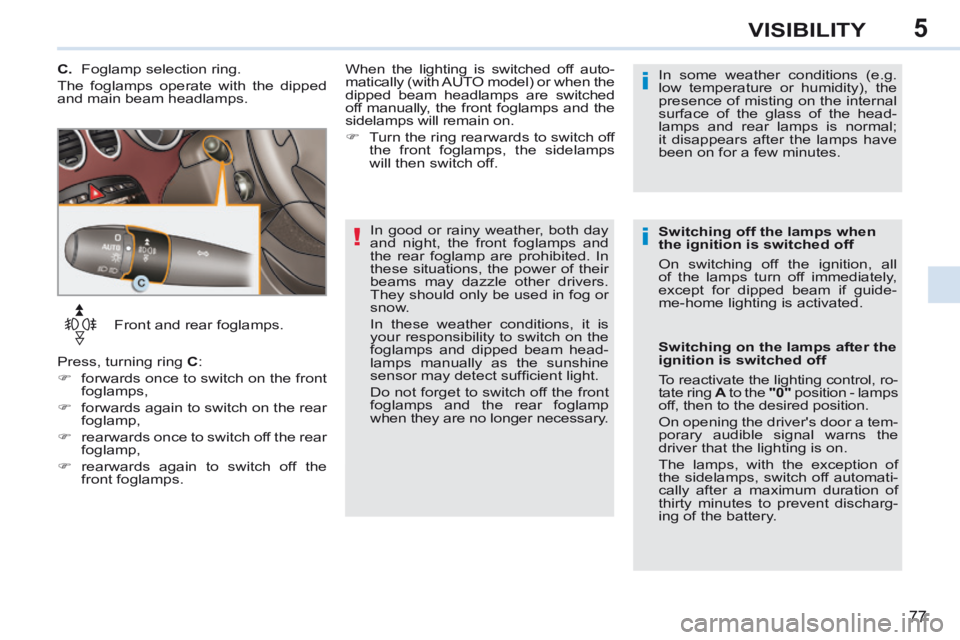
5
!i
i
77
VISIBILITY
Front and rear foglamps.
Press, turning ring C :
forwards once to switch on the front foglamps,
forwards again to switch on the rear foglamp,
rearwards once to switch off the rear foglamp,
rearwards again to switch off the front foglamps.
In good or rainy weather, both day
and night, the front foglamps and
the rear foglamp are prohibited. In
these situations, the power of their
beams may dazzle other drivers.
They should only be used in fog or
snow.
In these weather conditions, it is
your responsibility to switch on the
foglamps and dipped beam head-
lamps manually as the sunshine
sensor may detect suffi cient light.
Do not forget to switch off the front
foglamps and the rear foglamp
when they are no longer necessary.
Switching off the lamps when
the ignition is switched off
On switching off the ignition, all
of the lamps turn off immediately,
except for dipped beam if guide-
me-home lighting is activated.
C. Foglamp selection ring.
The foglamps operate with the dipped
and main beam headlamps.
In some weather conditions (e.g.
low temperature or humidity), the
presence of misting on the internal
surface of the glass of the head-
lamps and rear lamps is normal;
it disappears after the lamps have
been on for a few minutes.
Switching on the lamps after the
ignition is switched off
To reactivate the lighting control, ro-
tate ring A to the "0" position - lamps
off, then to the desired position.
On opening the driver's door a tem-
porary audible signal warns the
driver that the lighting is on.
The lamps, with the exception of
the sidelamps, switch off automati-
cally after a maximum duration of
thirty minutes to prevent discharg-
ing of the battery.
When the lighting is switched off auto-
matically (with AUTO model) or when the
dipped beam headlamps are switched
off manually, the front foglamps and the
sidelamps will remain on.
Turn the ring rearwards to switch off
the front foglamps, the sidelamps
will then switch off.
Page 80 of 268
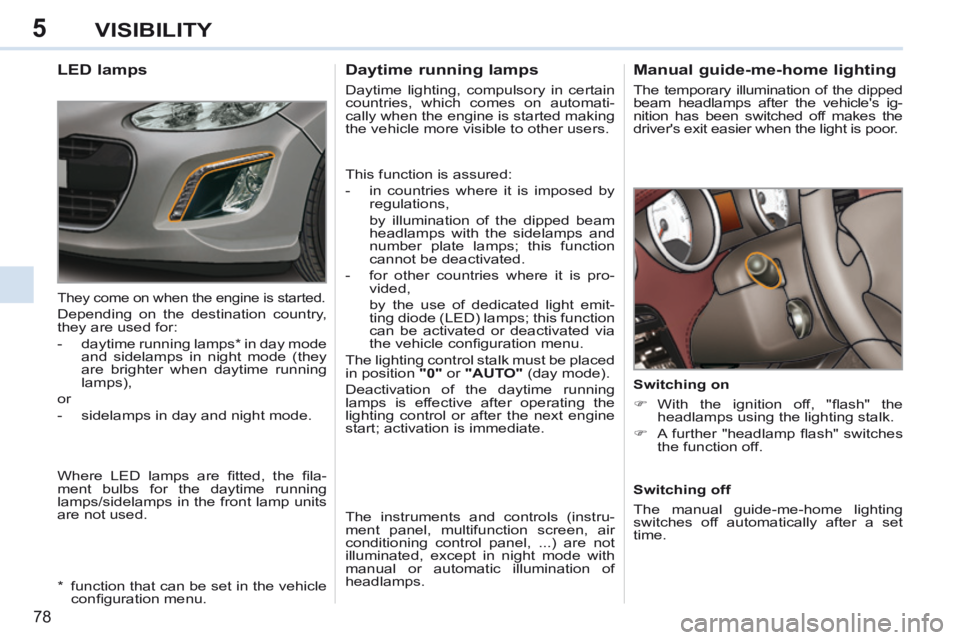
5
78
VISIBILITY
Manual guide-me-home lighting
The temporary illumination of the dipped
beam headlamps after the vehicle's ig-
nition has been switched off makes the
driver's exit easier when the light is poor.
Switching on
With the ignition off, "fl ash" the headlamps using the lighting stalk.
A further "headlamp fl ash" switches the function off.
Switching off
The manual guide-me-home lighting
switches off automatically after a set
time.
Daytime running lamps
Daytime lighting, compulsory in certain
countries, which comes on automati-
cally when the engine is started making
the vehicle more visible to other users.
This function is assured:
- in countries where it is imposed by regulations,
by illumination of the dipped beam headlamps with the sidelamps and
number plate lamps; this function
cannot be deactivated.
- for other countries where it is pro- vided,
by the use of dedicated light emit- ting diode (LED) lamps; this function
can be activated or deactivated via
the vehicle confi guration menu.
The lighting control stalk must be placed
in position "0" or "AUTO" (day mode).
Deactivation of the daytime running
lamps is effective after operating the
lighting control or after the next engine
start; activation is immediate.
The instruments and controls (instru-
ment panel, multifunction screen, air
conditioning control panel, ...) are not
illuminated, except in night mode with
manual or automatic illumination of
headlamps.
LED lamps
Where LED lamps are fi tted, the fi la-
ment bulbs for the daytime running
lamps/sidelamps in the front lamp units
are not used.
They come on when the engine is started.
Depending on the destination country,
they are used for:
- daytime running lamps * in day mode and sidelamps in night mode (they
are brighter when daytime running
lamps),
or
- sidelamps in day and night mode.
* function that can be set in the vehicle confi guration menu.